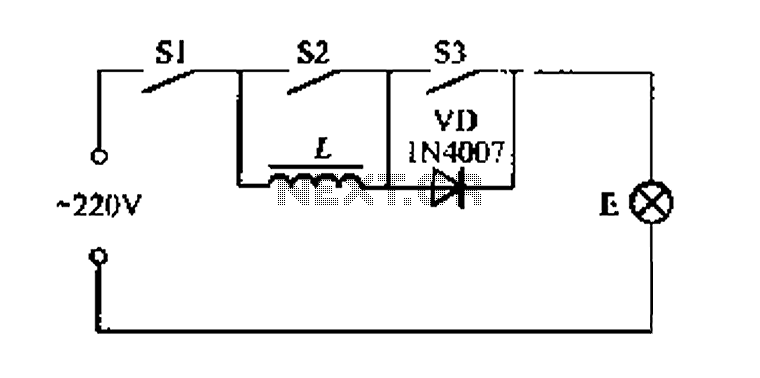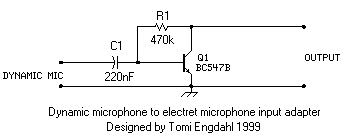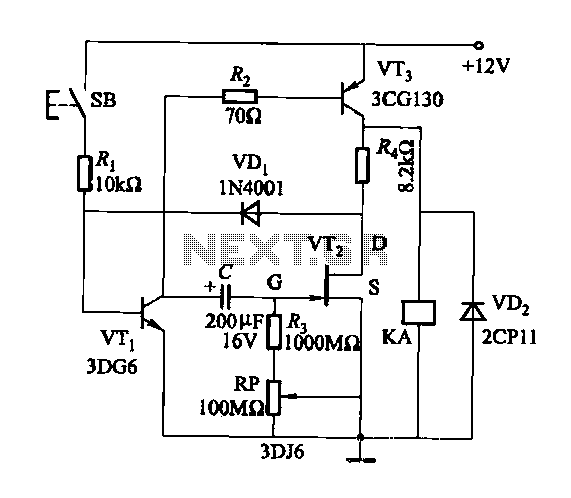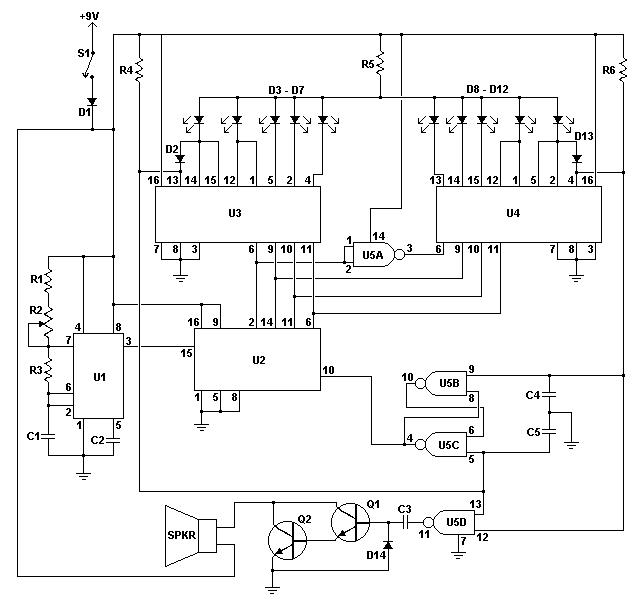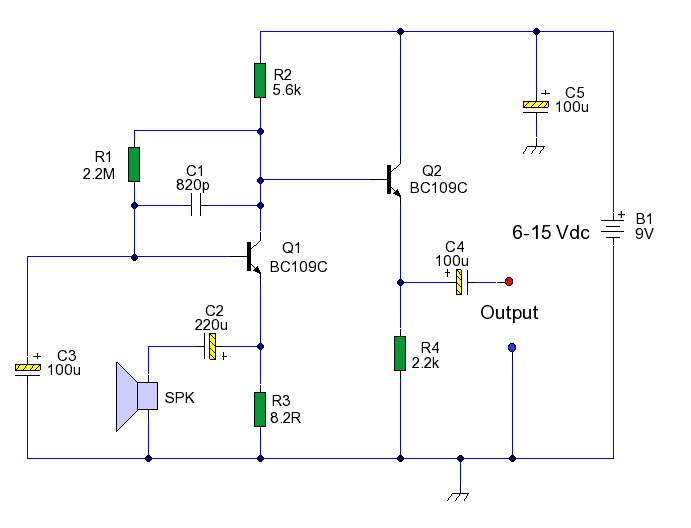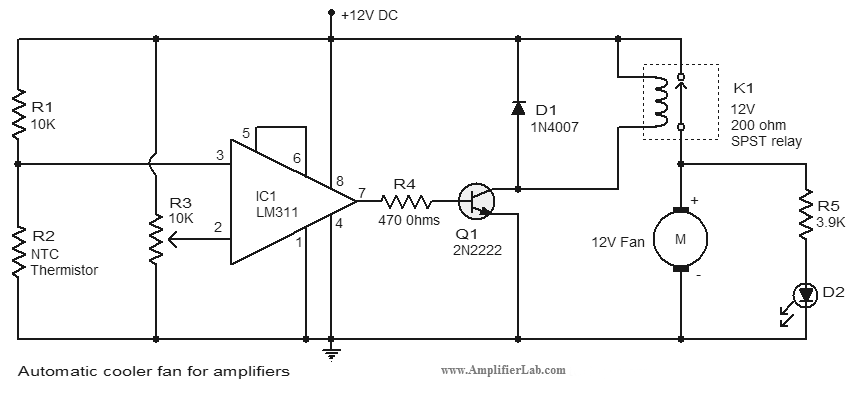
Stepping BA2101 touch dimmer light circuit
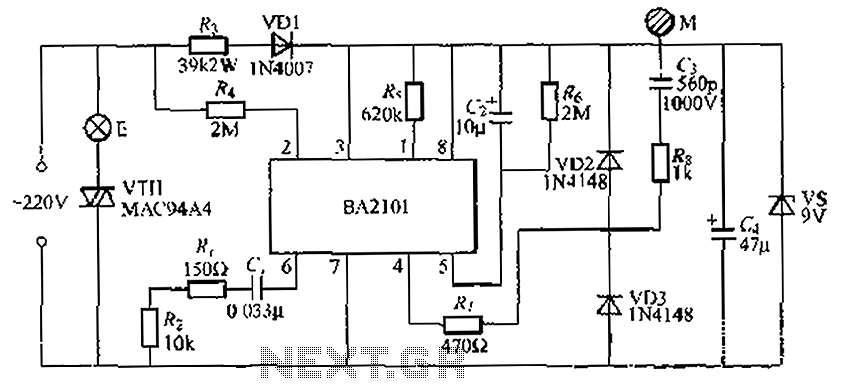
The BA2101 is a dimming controller utilizing an ASIC to create a barrel of light touch stepping. It is a non-constant lamp suitable for heir light. Each touch on the electrode sheet M can adjust the lamp brightness through a sequence of low light, medium light, strong light, and off states. The BEC BA2101 is produced by a lamp dimmer circuit, which employs a CMOS system packaged in a standard DIP-8 format. The pin functions are as follows: pin O is for the internal clock oscillation, pin SYN is the AC synchronous signal input, pin V is the positive power supply terminal, pin SP is the touch signal input, pin CI is for the external discharge resistor tolerance, pin TCO is the control signal output, pin VS is the negative power supply terminal, and pin 50/60Hz is for AC frequency selection. When the AC frequency is set to 50Hz, pin VDD is connected, and when set to 60Hz, this pin is left unconnected. The typical operating voltage for the BA2101 is DC 9V. The power supply circuit is composed of pins VD1, VS, and others, providing a 9V power supply voltage along with the AC synchronous signal. The circuit includes a resistor for the manifold, a full integration block for external vibration swing, a safe isolation capacitor, and the touch electrode sheet M. When a finger touches M, an induced signal is processed through the circuit, resulting in a trigger signal output from the first pin. This signal activates a thyristor, turning the lamp on. A second touch can modify the pulse output timing, allowing for changes in lamp brightness through repeated touches on M, cycling through low light, medium light, strong light, and off states. Adjustments to the discharge resistor and capacitor can further refine the brightness levels.
The BA2101 dimming controller is designed to provide a versatile solution for controlling lamp brightness through a user-friendly touch interface. The integration of an ASIC allows for efficient processing of touch inputs, enabling the user to cycle through different brightness settings seamlessly. The DIP-8 packaging facilitates easy integration into various applications, making it suitable for both consumer and industrial lighting systems.
The power supply circuit is critical for the BA2101's operation, ensuring stable voltage and reliable performance. The selection of AC frequency (50Hz or 60Hz) allows for compatibility with different power systems, enhancing its versatility. The inclusion of a discharge resistor and capacitor in the circuit design aids in the fine-tuning of brightness levels, allowing for a smooth transition between settings.
The touch-sensitive electrode M is a key component of this system, as it detects the user's input and generates the necessary signals for the BA2101 to function. The design ensures that minimal physical contact is required, making it ideal for applications where durability and ease of use are paramount.
Overall, the BA2101 dimming controller represents a sophisticated solution for modern lighting applications, combining advanced technology with user-friendly operation to achieve optimal performance in brightness control. BA2101 dimming using ASIC to produce a barrel of light touch stepping, Its a non- constant lamp suitable heir light. ~ Times each touch electrode sheet M, E lamp brightness can press the Low Light, qJ light, strong light, off, low light. step sequence cycle selection. BEC BA2101 is produced by lamp dimmer © Qi collector circuit, which uses CMOS1 arts system made standard DIP-8·? installed. Preparation cited thirty feet function as follows: O foot osc, internal clock oscillation external electrical resistance end; feet SYN, AC synchronous signal input terminal; feet V, power source positive terminal: foot SP, a touch signal input terminal; feet CI, external discharge resistor tolerance ends: foot TCO, the control signal output terminal; feet vs ., negative power supply terminal; feet 50/60Hz, AC frequency selection end, when the AC frequency is 50Hz, the termination VDD.
AC frequency is 60Hz, the ends dangling. BA 2101 typical operating voltage for DC 9V. Around the VD1, VS, foot s and (j composed of a power supply circuit, after power-chu (j ends also available 9V left the wine container flow manifold power supply voltage AC synchronous signal .Rt made for the manifold, R, full integration block external vibration swing I NIE resistor, r is the safe isolation capacitance, M for the touch electrode sheet. when a finger touches M, the body induced clutter signal by (, R, IC feet to the heart, after BA2101 internal circuit processes first pin outputs a trigger signal by the C-, R- product was added to VTH gate thyristor, thyristor VTH hunt through, lamp F lit.
M second touch, you can change the first frontier pin output pulse arrival time, and thus make the lamp brightness changes repeatedly touch M, according to the brightness of the bulb E: Low light + light one light one off a weak light groan. circulation changes decrease the discharge resistor R,. and numerical discharge capacitor c, can change the brightness difference Mang block.
The BA2101 dimming controller is designed to provide a versatile solution for controlling lamp brightness through a user-friendly touch interface. The integration of an ASIC allows for efficient processing of touch inputs, enabling the user to cycle through different brightness settings seamlessly. The DIP-8 packaging facilitates easy integration into various applications, making it suitable for both consumer and industrial lighting systems.
The power supply circuit is critical for the BA2101's operation, ensuring stable voltage and reliable performance. The selection of AC frequency (50Hz or 60Hz) allows for compatibility with different power systems, enhancing its versatility. The inclusion of a discharge resistor and capacitor in the circuit design aids in the fine-tuning of brightness levels, allowing for a smooth transition between settings.
The touch-sensitive electrode M is a key component of this system, as it detects the user's input and generates the necessary signals for the BA2101 to function. The design ensures that minimal physical contact is required, making it ideal for applications where durability and ease of use are paramount.
Overall, the BA2101 dimming controller represents a sophisticated solution for modern lighting applications, combining advanced technology with user-friendly operation to achieve optimal performance in brightness control. BA2101 dimming using ASIC to produce a barrel of light touch stepping, Its a non- constant lamp suitable heir light. ~ Times each touch electrode sheet M, E lamp brightness can press the Low Light, qJ light, strong light, off, low light. step sequence cycle selection. BEC BA2101 is produced by lamp dimmer © Qi collector circuit, which uses CMOS1 arts system made standard DIP-8·? installed. Preparation cited thirty feet function as follows: O foot osc, internal clock oscillation external electrical resistance end; feet SYN, AC synchronous signal input terminal; feet V, power source positive terminal: foot SP, a touch signal input terminal; feet CI, external discharge resistor tolerance ends: foot TCO, the control signal output terminal; feet vs ., negative power supply terminal; feet 50/60Hz, AC frequency selection end, when the AC frequency is 50Hz, the termination VDD.
AC frequency is 60Hz, the ends dangling. BA 2101 typical operating voltage for DC 9V. Around the VD1, VS, foot s and (j composed of a power supply circuit, after power-chu (j ends also available 9V left the wine container flow manifold power supply voltage AC synchronous signal .Rt made for the manifold, R, full integration block external vibration swing I NIE resistor, r is the safe isolation capacitance, M for the touch electrode sheet. when a finger touches M, the body induced clutter signal by (, R, IC feet to the heart, after BA2101 internal circuit processes first pin outputs a trigger signal by the C-, R- product was added to VTH gate thyristor, thyristor VTH hunt through, lamp F lit.
M second touch, you can change the first frontier pin output pulse arrival time, and thus make the lamp brightness changes repeatedly touch M, according to the brightness of the bulb E: Low light + light one light one off a weak light groan. circulation changes decrease the discharge resistor R,. and numerical discharge capacitor c, can change the brightness difference Mang block.
